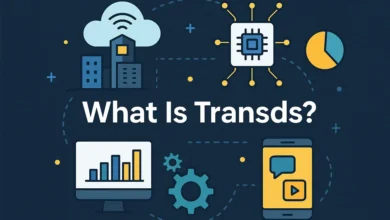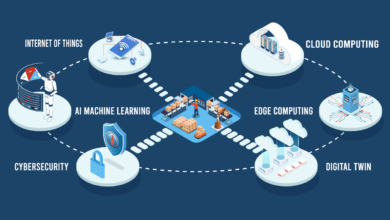What is Blockchain Technology? How Does Blockchain Work?

In the world of technology, one buzzword that’s been floating around for quite some time is blockchain. You’ve probably heard about it in discussions about cryptocurrencies, secure transactions, or even business innovations. But what exactly is blockchain technology, and how does it work? Let’s dive into the nuts and bolts of it all and break down this often-complex topic in a simple, digestible way.
What Is Blockchain Technology?
In its simplest form, blockchain is a type of distributed ledger technology (DLT). It’s a system that allows data to be stored across a network of computers in such a way that the record can’t easily be altered, hacked, or faked. Imagine it like a digital notebook, but instead of having one copy that could be altered by anyone with access, the notebook is duplicated across multiple users or nodes, and each copy is linked to the others.
This decentralized approach ensures that no single party can control or tamper with the data. The technology was initially created to support Bitcoin, the first cryptocurrency, but blockchain has now branched out into numerous sectors, including supply chain management, healthcare, and finance.
At the core, blockchain can be visualized as a series of blocks linked together (hence, “blockchain”). Each block contains a list of transactions, and once a block is filled, it’s “chained” to the next one in line. This chaining is what makes the system secure.
Key Characteristics of Blockchain Technology
Before we dive into the mechanics of how blockchain works, let’s take a look at some of its most important characteristics:
Decentralization: Unlike traditional databases or record-keeping systems, blockchain operates on a decentralized network. This means that data isn’t stored in one central location but is instead spread across multiple computers or nodes.
Immutability: Once data is recorded on the blockchain, it cannot be changed or deleted. This feature ensures transparency and trust because users know that the record is permanent.
Security: Blockchain uses advanced cryptographic techniques to secure data. Each block has its cryptographic hash (a unique string of numbers and letters), which makes altering the data extremely difficult without detection.
Transparency: Since blockchain operates on a distributed ledger, anyone on the network can view the transactions. This transparency builds trust among users, as no single entity controls the entire system.
Efficiency: With blockchain, there’s no need for intermediaries like banks or brokers. This can lead to faster transactions and lower costs, particularly in financial services.
Now that we’ve covered the basics, let’s move on to how blockchain works.
How Does Blockchain Work?
Blockchain operates in a pretty straightforward manner when you break it down. Let’s explore the steps involved in how it works:
A Transaction is Initiated
The blockchain process begins when a transaction is initiated. This could be anything from transferring cryptocurrency between two parties, recording the movement of goods in a supply chain, or even registering an asset like real estate.
For example, if you want to send some Bitcoin to a friend, you’ll initiate the transaction on the Bitcoin blockchain.
Transaction Details are Sent to a Network of Nodes
Once the transaction is created, it is sent to a network of computers, or nodes, across the world. These nodes are responsible for validating the transaction.
These nodes use algorithms to confirm whether the transaction is legitimate. They check factors like whether the sender has enough assets (in the case of cryptocurrency) or whether the details of the transaction align with previous records.
Nodes Validate the Transaction
After receiving the transaction details, the nodes work together to validate it. They do this through consensus mechanisms, the most common of which is Proof of Work (PoW).
With Proof of Work, nodes (also called miners) solve complex mathematical puzzles to validate the transaction. This process is energy-intensive and time-consuming, but it helps ensure that the transaction is legitimate and can’t be easily tampered with.
Another common consensus mechanism is Proof of Stake (PoS), which is more energy-efficient but operates on a different principle: the creator of a new block is chosen based on their stake in the blockchain, usually measured by how many tokens they hold.
The Transaction is Added to a Block
Once the transaction is validated, it’s added to a block of other transactions. Each block can store thousands of transactions, depending on the blockchain being used.
In the case of Bitcoin, a block can hold about 1 MB of data, which translates to roughly 2,000 transactions.
The Block is Linked to the Chain
After the block is filled with transactions, it’s added to the existing blockchain in chronological order. This process involves linking the newly created block with the one before it using a cryptographic hash.
Each block’s hash is unique, and it contains information from the previous block. This is what makes blockchain so secure—altering any block in the chain would require changing all subsequent blocks, which is nearly impossible due to the decentralized nature of the network.
Transaction is Complete
Once the block is added to the chain, the transaction is complete. At this point, the transaction is permanent and can’t be altered. It’s now a part of the blockchain’s immutable ledger.
In the case of a Bitcoin transaction, your friend would now have the cryptocurrency you sent them, and that record is stored across thousands of computers, ensuring its security.

Benefits of Blockchain Technology
Blockchain technology comes with several advantages, which is why it’s quickly gaining traction in industries beyond cryptocurrency. Some of the key benefits include:
Enhanced Security: The decentralized and cryptographic nature of blockchain makes it highly secure. Transactions are encrypted, and once added to the blockchain, they cannot be altered.
Greater Transparency: With its distributed ledger, anyone can verify the transactions, leading to a transparent system where all participants have access to the same information.
Increased Efficiency: Blockchain eliminates the need for intermediaries, which can reduce transaction times and costs, especially in industries like finance and supply chain management.
Reduced Fraud: Blockchain’s immutability and decentralized structure make it very difficult for bad actors to manipulate the system.
Real-World Applications of Blockchain
Blockchain technology isn’t just theoretical; it’s already being used in many real-world applications. A few examples include:
Cryptocurrencies: The most famous application of blockchain is in cryptocurrencies like Bitcoin and Ethereum. Blockchain allows these digital currencies to operate without the need for a central authority.
Supply Chain Management: Companies like Walmart are using blockchain to track the movement of goods in their supply chain, increasing transparency and efficiency.
Smart Contracts: On platforms like Ethereum, blockchain is used to create self-executing contracts. These contracts automatically fulfill when predefined conditions are met, without the need for a third party.
Conclusion:
Blockchain technology has the potential to revolutionize industries by offering a secure, transparent, and efficient way to record transactions. Though it may sound complex at first, understanding the basics of how it works reveals why it’s generating so much excitement. As blockchain continues to evolve, its applications will likely expand, bringing even more innovative solutions to the modern world. Whether you’re looking at cryptocurrencies or the broader scope of decentralized technology, blockchain is a game-changer that’s here to stay.



